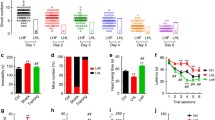Abstract
The phenomenon known as “learned helplessness” (LH) is seen broadly across the animal kingdom. Some of the basic characteristics of this behavior are: failure to escape shock when it is possible to do so following non-escapable shock; reversion to non-escape behavior even after successful escape; if the animal is given escape/avoidance training prior to being given inescapable shocks, the latter will not interfere with its ability to later show normal escape/avoidance behavior (generally described as an immunization effect); following inescapable shock training the animals often become “passive and still” when confronted with an escapable shock. These behaviors are seen in intact mammals, lower vertebrates, and invertebrates. In fact, the basic characteristics are even seen in a spinal rat and, with the exception of one characteristic not yet examined, in an isolated thoracic ganglion of an insect. The brain is evidently not essential either in mammals or in invertebrates for demonstrating this behavior. Not only can an insect ganglion show the behavioral characteristics of LH, but the neural information underlying the phenomenon of LH can be shown to transfer from one ganglion innervating one pair of legs to another ganglion innervating a different pair of legs. Thus, how CNS information underlying LH is coded and transferred from one site to another within the CNS can be examined in such a system. The LH model has provided valuable insights into the physiology of depression. This model suggests that human depression is caused by one’s lack of control over traumatic events. It is supported by a number of parallels between depression and LH behavior. Tricyclic antidepressants, MAO inhibitors, and ECT, which are effective in treating depression, also can prevent and reverse LH in mammals. It would be important to find out if they are also effective in invertebrate models. The fact that the characteristics of the behavior called LH are seen in invertebrates such as slugs, cockroaches, and locusts provokes other intriguing questions about the presence of cognition at these phylogenetic levels, as well as what animal or preparation constitutes an appropriate model for human depression.
Similar content being viewed by others
References
Brady, J.V., Porter, R.W., Conrad, G., Mason, J.W. (1958) Avoidance Behavior and the Development of Gastroduodenal Ulcers,Journal of Experimental Analysis of Behavior, 1(1): 69–72.
Brown, G.E., Anderson, C.L., Scruggs, J.L. (1994) Shock-Induced Analgesia in the Cockroach,P. americana.Psychological Reports, 74: 1051–1057.
Brown, G.E., Busby, P.L., Klopfenstein, M.K. (1992) Decay and Reversibility of Learned Helplessness in the Cockroach,P. americana.Psychological Reports, 71: 1107–1113.
Brown, G.E., Davenport, D.A., Howe, A.R. (1994) Escape Deficits Induced by a Biologically Relevant Stressor in the Slug,L. maximus.Psychological Reports 75: 1187–1192.
Brown, G.E., Howe, A.R., Jones, T.E. (1990) Immunization against Learned Helplessness in the Cockroach,P. americana.Psychological Reports 67: 635–640.
Brown, G.E., Stroup, K. (1988) Learned Helplessness in the Cockroach,P. americana.Behavioral and Neural Biology 50: 246–250.
Buerger, A.A., Eisenstein, E.M., Reep, R.L. (1981) The Yoked Control in Instrumental Avoidance Conditioning: An Empirical and Methodological Analysis.Physiological Psychology 9(4):351–353.
Church, R.M., Lerner, N.D. (1976) Does the Headless Roach Learn to Avoid?Physiological Psychology 4(4): 439–442.
Eisenstein, E. M. (1997) Selecting a Model System for Neurobiological Studies of Learning and Memory.Behavioral Brain Research 82: 121–132.
Eisenstein, E.M., Carlson, A.D. (1997) A Comparative Approach to the Behavior Called “Learned Helplessness”.Behavioral Brain Research 86: 149–159.
Eisenstein, E.M., Reep, R.L. (1985) Behavioral and Cellular Studies of Learning and Memory in Insects. InComprehensive insect physiology, biochemistry and pharmacology (vol. 9) G.A. Kerkut and L.I. Gilbert (Eds). Oxford: Pergamon Press, pp. 513–547.
Eisenstein, E.M., Kemeny, G., Skurnick, I.D., Harris, J.T. (1972) Transfer of Information within the Cockroach Central Nervous System during Shock Avoidance Learning: Is There a Nerve Impulse Code(s) for Learned Information?International Journal Neuroscience 3: 93–98.
Eisenstein, E.M., Cohen, M.J. (1965) Learning in an Isolated Prothoracic Insect Ganglion.Animal Behavior 13(1): 104–108.
Harris, J.T. (1971) Learning in Roach Ganglia. Ph.D. Thesis, Tufts University.
Horridge, G.A. (1962) Learning of Leg Position by the Ventral Nerve Cord in Headless Insects. Proceedings of the Royal Society B 157:33–52.
Overmeir, J.B. (1968) Interference with Avoidance Behavior: Failure to Avoid Traumatic Shock.Journal of Experimental Psychology, 78(2): 340–343.
Overmeir, J.B., Seligman, M.E.P. (1967) Effects of Inescapable Shock upon Subsequent Escape and Avoidance Responding,Journal of Comparative and Physiological Psychology 63(1): 28–33.
Pak, K-Y, Harris, C.L. (1975) Evidence for a Molecular Code for Learned Shock-Avoidance in Cockroaches.Comparative Biochemistry and Physiology, 52A: 141–144.
Perkel, D.H., Bullock, T.H. (1968) Neural Coding,Neurosciences Research Progress Bulletin 6(3): 221–348.
Petty, F., Sherman, A. (1982) A Neurochemical Differentiation between Exposure to Stress and the Development of Learned Helplessness.Drug Development Research 2(4): 43–45.
Reep, R.L., Eisenstein, E.M., Tweedle, C.D. (1980) Neuronal Pathways Involved in Transfer of Information Related to Leg Position Learning in the Cockroach,P. americana.Physiology and Behavior 24: 501–513.
Sagen, J., Sortwell, C.E., Pappas, G.D. (1990) Monoaminergic Neural Transplants Prevent Learned Helplessness in a Rat Depression Model.Biological Psychiatry 28: 1037–1048.
Sherman, A.D., Sacquitne, J.L. Petty, F. (1982) Specificity of the Learned Helplessness Model of Depression,Pharmacology Biochemistry and Behavior 16: 449–454.
Sherman, A.D., Petty, F. (1980) Neurochemical Basis of the Action of Antidepressants on Learned Helplessness.Behavioral and Neural Biology 30: 119–134.
Sherman, A.D., Allers, G.L., Petty, F., Henn, F.A. (1979) A Neuropharmacologically-relevant Animal Model of Depression,Neuropharmacology 18: 891–893.
Sortwell, C.E., Sagen, J. (1993). Induction of Antidepressive Activity by Monoaminergic Transplants in Rat Neocortex,Pharmacology Biochemistry and Behavior 46: 1–6.
Author information
Authors and Affiliations
Corresponding author
Rights and permissions
About this article
Cite this article
Eisenstein, E.M., Carlson, A.D. & Harris, J.T. A ganglionic model of “learned helplessness”. Integrative Physiological and Behavioral Science 32, 265–271 (1997). https://doi.org/10.1007/BF02688624
Issue Date:
DOI: https://doi.org/10.1007/BF02688624




